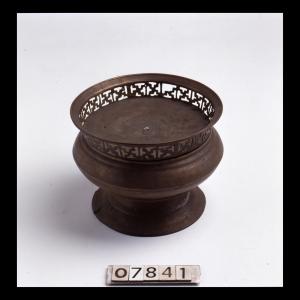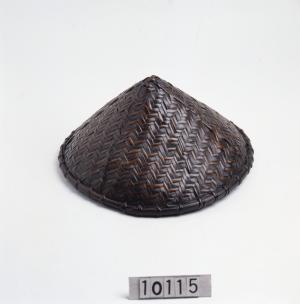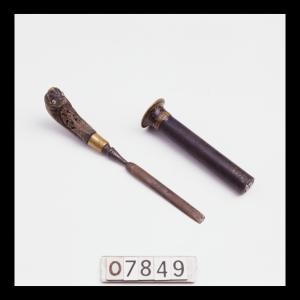Volume I (Abstract)
In the traditional culture, it is believed that pregnancy depended upon intervention of the rutux (the ghost). Although conception is believed to be due to sexual intercourse, it is believed to be bestowed by the rutux. To keep the baby safe during gestation, the pregnant woman use a rattan belt around her waist and observe a number of taboos.
The pregnant woman continues to do her daily work until the time of delivery. As birth is considered unclean, delivery in the open is avoided in order to keep the rutux from getting angry. At the moment of birth, except mother and sisters of the delivering woman, no other person is allowed to be present, especially the husband. The first birth is considered most important and always takes place with the magician's help. Usually mothers begin their housework again on the day of delivery. Until the baby's navel cord is dry, which takes three to five days, the mother is not allowed to leave her house.
Placenta and navel cord of a boy are buried near the back wall of the house, those of a girl beside the front wall. On day following birth, or soon after birth, the father sends some wine to all the relatives to announce the arrival of the new baby.
A deformed child is killed soon after birth. Twins are thought to be ill omen, but usually they are allowed to live. Premarital sexual relations are tabooed and an illegitimate child brings shame upon the mother and her family. After an illegitimate birth, a pig has to be killed as sacrifice to the ghost as well as compensation to the people of the same ritual group.
The Atayal use both the patranymic and matranymic linkage systems depending upon whether the particular family is matrilocal or patrilocal. The first name is the child's own name and the second that of his parent's. Each child is named ten days or more after his birth by the grandparents. Most Atayal names are based on words for natural phenomena, animals, or plants.
Babies are nursed immediately after birth. Feeding is based on demand. Crying is always responded to by nursing or by holding. At three or four months babies are also fed porridge made of millet. Usually nursing continues for one year but sometimes lasts through the second year. Sometimes a child is weaned by smearing the nipple with capsicum or bitter tasting substances.
The main reason for weaning is the mother's next pregnancy. After the child's young sibling is born, children are nursed together two at times.
There are two main physical settings for socialization. One is around the house in the village, another is the mountain field. During daytime, babies are put in blankets slung between trees while their parents are working. In the evening, the infant sleeps in the same bed with mother and father. Older children sleep in a separate bed in the same common room.
Mother, older siblings and grandparents serve as caretaker. The family is a fundamental unit in socialization, but the agents can be spread among relatives such as uncles and aunts either patri- or matrilineal.
From the very early days, children are trained to respect and fear the supernatural beings. They believe that the rutux are everywhere in the world.
In the traditional culture, education takes place through contact with parents, kins and playmates. There are no formal procedures for teaching. No effort is made to directly teach language or concepts, as children are expected to learn adequately through observation and imitation.
Model of weapons, such as bow and arrows are the boy's favorite toys. The boys play games involving both competition between individuals and between teams. Some games are aggressive, such as wrestling and stone throwing, others involve physical competition, such as racing etc. Play is highly sex typed and involves enacting domestic activities and roles.
Children under three are not punished. If an infant cries, he is held or swung to the back. Physical punishment is seldom undertaken by parents. The father punishes children only when they have committed some extraordinary misdeed such as stealing. Children are slapped more often by their elder brothers. Older children are given authority over younger children in the parents' absence with full powers of punishment.
The common objects of aggression for children are animals. Fighting occurs very often among children but compromises follow quickly. Older children display physical aggression toward the younger siblings in the parents' absence.
Babies are swaddled in a blanket from birth to eight months. Rags are used as diapers but the parents scarcely have time to change them. No training of sphincter control is made by the adults during early childhood. Children are ordered to excrete outside the house when more than five years old. Training is not severe however, and bedwetting is not punished.
In general, cleanliness is not considered seriously, and children are not expected to bath themselves before age of ten. There is little cleanliness training.
Parents' attitudes toward the infant's or child's dependence are inconsistant. The infant's dependence is treated with both extreme indulgence, like that of the Kwoma described by Whiting, and a great lack of indulgence like that of the Ainu.
After weaning, the baby is taken care by his grandmother or older siblings now and then. So children are used to adapt to the inconsistant environment at two or three years and do not protest separation from their mother at the same age. No severe independence training is practiced by the parents.
Children under eight go without clothes in warm weather. Accordingly exhibitionism and fingering of genitals are considered innocent. Young children's sex play is forbidden but is not punished and is considered to be quite harmless. Masturbation in adolescence is more or less expected, but is practiced in secret. Since the children sleep with their parents in the same bed and with the opportunity to witness adult sexual behavior, they acquire knowledge of sexual intercourse early. Before puberty, at the age of ten or more, children are trained to the concept that premarital hetero-sexual intercourse is shameful and should be avoided.
Children give serious help with the housework at about ten, and training in adult work starts at the same time. At about the time the boys show signs of puberty, they begin to do the rough work, such as cultivation, hunting, house-building, logging and rattan gathering. The boys accompany their father hunting from the age of eight until adulthood.
For girls, housework and weaving are the most important tasks. They learn the technique of weaving early by observation and are expected to become skillful weaver around fifteen.
Usually the adults said: “We don't teach the children on purpose, they learn by themselves.” But the data indicate that mild reward and punishment are used for training.
Ceremonial initiation does not exist among the Atayal. There are no ceremonies concerning girl's first menstruation. During the early years of childhood, there are no restraints between brothers and sisters. But at the onset of puberty, that is when secondary physical sex characteristics begin to develop, girls are expected to be reserved in the presence of their brother's, and avoid joking with the older brothers. After puberty, parents often warn the child to keep away from the opposite sex.
Adult status is signified by tattooing on the face of both sexes. Tattooing takes place during puberty at the parents' decision, and it is a necessary qualification for marriage.





